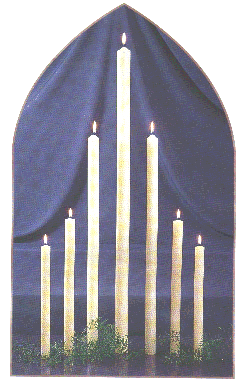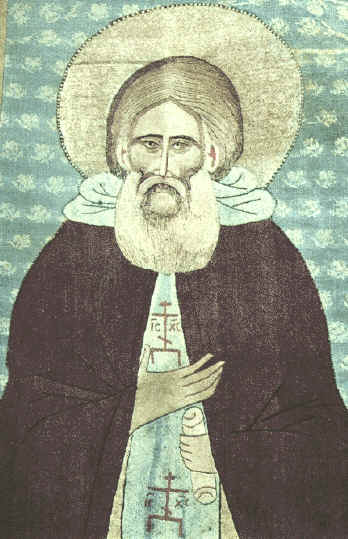CANDLEMAS – FESTIVAL OF LIGHT
Lighten our hearts we beseech you, O
God with the light of your presence and purify our lives with the refining fire
of your spirit so that in purity and love our whole being may reflect and
radiate the glory of God in the world of darkness.
 Between
Epiphany and Lent is Candlemas, the third festival of the Christian year. Jewish
law decreed that after giving birth to a boy child, every mother
was to be excluded from public worship for forty days. She would then make an
offering to God so purifying herself. Thus, forty days after the birth of Jesus,
his mother Mary presented herself at the Temple – St Luke’s Gospel, chapter
two, verse 22 "And to Jerusalem, to present him to the Lord". Mary’s
purification very quickly became a celebrated event in the calendar of the early
Church – the Feast of the Purification of the Blessed Virgin Mary. Originally
it fell on the 14th February because the birth of Christ was then
celebrated on the Feast of the Epiphany, January 6th. There is an
early account of the feast in a diary of Egeria, a lady from a Roman province in
Spain. She made a pilgrimage to the Holy Land in 380 and she describes the
procession and mass in Jerusalem. At this time the festival had no special name
and was simply referred to as "the fortieth day after Epiphany".
Between
Epiphany and Lent is Candlemas, the third festival of the Christian year. Jewish
law decreed that after giving birth to a boy child, every mother
was to be excluded from public worship for forty days. She would then make an
offering to God so purifying herself. Thus, forty days after the birth of Jesus,
his mother Mary presented herself at the Temple – St Luke’s Gospel, chapter
two, verse 22 "And to Jerusalem, to present him to the Lord". Mary’s
purification very quickly became a celebrated event in the calendar of the early
Church – the Feast of the Purification of the Blessed Virgin Mary. Originally
it fell on the 14th February because the birth of Christ was then
celebrated on the Feast of the Epiphany, January 6th. There is an
early account of the feast in a diary of Egeria, a lady from a Roman province in
Spain. She made a pilgrimage to the Holy Land in 380 and she describes the
procession and mass in Jerusalem. At this time the festival had no special name
and was simply referred to as "the fortieth day after Epiphany".
 By
the seventh and eighth centuries it had become the Purification of Mary and was
now celebrated on February 2nd (forty days after Christmas.) In 701
Pope Sergius I introduced the candles into the procession. Light was a symbol of
goodness and purity – Jesus Christ is "the light of the world."
Later at the end of the eighth century the blessing of the candles was included
in the rite and the celebrant of the Mass distributed them to the congregation.
After the blessing the procession, and it if from this procession of lights
comes the name Candlemas.
By
the seventh and eighth centuries it had become the Purification of Mary and was
now celebrated on February 2nd (forty days after Christmas.) In 701
Pope Sergius I introduced the candles into the procession. Light was a symbol of
goodness and purity – Jesus Christ is "the light of the world."
Later at the end of the eighth century the blessing of the candles was included
in the rite and the celebrant of the Mass distributed them to the congregation.
After the blessing the procession, and it if from this procession of lights
comes the name Candlemas.
In medieval times the Pope used to distribute
blessed candles from his window. However, it became somewhat hazardous with the
crowds and there were accidents. In 1573 Pope Gregory XIII abolished the
ceremony. Other customs replaced it and at the end of the eighteenth century
large, beautifully decorated candles were offered to the Pope in hall of the
Consistory (cardinals’ court) every year on Candlemas Day. He then distributed
them to the poorer churches of his diocese.
In some countries special candles are brought
along to the blessing by the worshippers. These are often very elaborate and are
highly treasured. Afterwards they are taken home and kept to be lighted at times
of stress – during storms, in sickrooms and at the bedside of the dying. In
Poland there is a legend that the Virgin Mary watches on winter nights, around
Candlemas when hungry wolves prowled the villages. With her Thunder Candle she
would ward off the wolves thus protecting the villagers from harm.
Candlemas shares with another feast day, that of
St Swithin, a reputation for being a great day for weather forecasting. Bad
weather and cloudy skies on February 2nd mean an early and prosperous
summer! However, if the sun shines for the greater part of the day there will be
forty more days of cold and snow! (Alas there is always a catch!)
Candlemas is also associated with change and with
looking forward. In days gone by, tenant farmers had to pay their rents at
Candlemas and farm labourers and maids often moved on to their new employers
ready to begin work on February 3rd. Christmas decorations and every
last trace of greenery in churches and homes were removed. Christmas plants and
the remnants of the Yule log were burned and the ashes spread in gardens and
fields to ensure healthy growth in the spring. All was made ready for the
purification and the lighting of the candles on Candlemas Day, the celebration
of Jesus Christ as the light of the world.
Barbara Hothersall
 Between
Epiphany and Lent is Candlemas, the third festival of the Christian year. Jewish
law decreed that after giving birth to a boy child, every mother
was to be excluded from public worship for forty days. She would then make an
offering to God so purifying herself. Thus, forty days after the birth of Jesus,
his mother Mary presented herself at the Temple – St Luke’s Gospel, chapter
two, verse 22 "And to Jerusalem, to present him to the Lord". Mary’s
purification very quickly became a celebrated event in the calendar of the early
Church – the Feast of the Purification of the Blessed Virgin Mary. Originally
it fell on the 14th February because the birth of Christ was then
celebrated on the Feast of the Epiphany, January 6th. There is an
early account of the feast in a diary of Egeria, a lady from a Roman province in
Spain. She made a pilgrimage to the Holy Land in 380 and she describes the
procession and mass in Jerusalem. At this time the festival had no special name
and was simply referred to as "the fortieth day after Epiphany".
Between
Epiphany and Lent is Candlemas, the third festival of the Christian year. Jewish
law decreed that after giving birth to a boy child, every mother
was to be excluded from public worship for forty days. She would then make an
offering to God so purifying herself. Thus, forty days after the birth of Jesus,
his mother Mary presented herself at the Temple – St Luke’s Gospel, chapter
two, verse 22 "And to Jerusalem, to present him to the Lord". Mary’s
purification very quickly became a celebrated event in the calendar of the early
Church – the Feast of the Purification of the Blessed Virgin Mary. Originally
it fell on the 14th February because the birth of Christ was then
celebrated on the Feast of the Epiphany, January 6th. There is an
early account of the feast in a diary of Egeria, a lady from a Roman province in
Spain. She made a pilgrimage to the Holy Land in 380 and she describes the
procession and mass in Jerusalem. At this time the festival had no special name
and was simply referred to as "the fortieth day after Epiphany". By
the seventh and eighth centuries it had become the Purification of Mary and was
now celebrated on February 2nd (forty days after Christmas.) In 701
Pope Sergius I introduced the candles into the procession. Light was a symbol of
goodness and purity – Jesus Christ is "the light of the world."
Later at the end of the eighth century the blessing of the candles was included
in the rite and the celebrant of the Mass distributed them to the congregation.
After the blessing the procession, and it if from this procession of lights
comes the name Candlemas.
By
the seventh and eighth centuries it had become the Purification of Mary and was
now celebrated on February 2nd (forty days after Christmas.) In 701
Pope Sergius I introduced the candles into the procession. Light was a symbol of
goodness and purity – Jesus Christ is "the light of the world."
Later at the end of the eighth century the blessing of the candles was included
in the rite and the celebrant of the Mass distributed them to the congregation.
After the blessing the procession, and it if from this procession of lights
comes the name Candlemas.